The Yoruba are the largest cultural group on the African continent, with nearly 40 million people. The word ‘Yoruba’ describes both the language and a tribe living across Nigeria and the Popular Republic of Benin, in an area of forest and savannah.
Geography
The Yoruba people’s primary living space is South-West Nigeria with substantial Yoruba communities in Benin, Togo and Sierra Leone but they are not bound by state or country borders. This area is often referred to as “Yorubaland”. Most of the terrain is either forest, woodland savannah, rich farmland or coastal swamps and lagoons.
History
The origin of the Yoruba people in Nigeria is heavily debated. Some believe they came from the east in Mecca, some say from the north in Egypt. Evidence shows that ethnically, Yoruba’s have been in the area known as Yorubaland since the 7th century BC. Scholars believe the area was probably inhabited earlier by peoples of the Nok culture. Yorubaland covers the modern-day countries of Nigeria, Togo and Benin. The term Yoruba to describe ethnicity, did not come about until the 16th century and wasn’t widely used until the 19th century. Before then, the Yoruba people were known by many names depending on who was acknowledging them. For instance, the Europeans referred to them as Akú, whereas in Cuba, they were referred to as O luku mi.
Yorubaland was originally made up of 16 kingdoms and many other sub-kingdoms and territories that are second order branches of the initial 16. Each kingdom is ruled by an Oba (king), though each may have a different political way of running things. In some states, the Oba had complete control whereas in others, the council members made most decisions. Kingship was often passed down through generations, but not in the traditional way. An electoral college was held to select a member of one of the many royal families. A royal family could be completely excluded from kingship if any person of that family committed a crime such as theft, murder, or rape.
By the 8th century AD, the Yoruba created one of the earliest known kingdoms in Africa. A system of defensive walls was erected called Sungbo’s Eredo. More than 99 miles long and 66 ft high, it is the largest pre-colonial monument in Africa, larger than the Great Pyramid. A connection between the Queen of Sheba has been recounted in both the Bible and Quran, although recent archaeology might prove that the timeline is off.
Sprouting up organized urban cities since the 12th century, the Yoruba surpassed most other cultures nearby. They created towns with fortresses and high walls centered around the Oba and most Yoruba lived in well-structured homes.
In the 15th century, the Oyo Empire was founded and became one of the largest West African states. Ruled by an Oba, also known as Alaafin of Oyo, the Empire eventually grew so big they began having a presence among neighboring kingdoms.
During the 17th and 18th century, the Oyo Empire was taking part in the African slave trade and the Yoruba were among the most profoundly besieged people. The Oba demanded slaves as a form of payment from its subjects and would sell them to Europeans and Americans. In order to capture the required number of slaves, many wars were pursued.
Today, due to the slave trade and self-migration, descendants of the Yoruba can be found all over the world, but most abundantly in Canada, U.S., Cuba, Brazil and the Caribbean.
Art
Yoruba people are prolific artists and craftsmen. Most of the Yoruba artifacts date from between the end of the 19th century and the middle of the 20th century and can often be attributed to a specific carver by name – an exception in African art
An array of materials are used by the Yoruba including bronze, leather, terracotta, ivory, wood, glass and more. Many realistic bronze sculptures have been found that are believed to date back to the 12th century. When found by some Europeans, it was thought that the artwork had to have come from an outside source, many believed ancient Greeks or Romans. No one could believe the amount of skilled craftsmanship required could possibly come from a civilization once thought to be inferior to that of the Western world.
Most Yoruba art has a meaning or purpose behind it. Some items are carved for worship or for celebration, sometimes as a commemoration of Yoruba culture. Many carvers come from a long familial lineage of artists and spend many years studying new and ancient techniques.
A tradition of the Yoruba are annual and seasonal masquerades. Masquerades are held for different purposes and meanings such as worship, celebration, harvest etc. Huge festivals are held that can sometimes last days. A great amount of work goes into the construction of these events. Costumes and masks need to be made, performances rehearsed, food preparation etc. The masks and clothing associated with these festivities are considered sacred and are not supposed to be touched by an ordinary person or they may lose their power. Some costumes are passed down for generations.
Religion
Mythology
The Yoruba faith, also known as Aborisha, Orisha-Ifa or “Ifa” is seen as one of Africa’s traditional religions’ principal components.
Obatala, also known as Orisa’nla was the arch-divinity chosen by the Supreme God, Olodumare, to create land out of water which made up the earth and began populating the land with humans that were molded from clay. Along the way, Obatala found and drank some palm wine and became intoxicated. Due to this, the younger brother, Oduduwa, took the items of creation from him, climbed down from the heavens on a chain and threw a handful of earth on the ocean, and proceeded to put a cockerel down so that it would scatter the earth with its’ claws. The land that was created would be known as “Ile Ife”, the spiritual homeland the Yoruba would build.
Due to this account of the story, Oduduwa became the ancestor of the first divine king of the Yoruba, while Obatala is believed to have created the first Yoruba out of clay.
“Ife” in Yoruba translates to “expansion. Ile-Ife references the myth of origin by translating to “The Land of Expansion”.
Oral history of the Oyo-Yoruba recounts Odùduwà to be the Progenitor of the Yoruba and the reigning ancestor of their crowned kings.
After Oduduwa’s death, his children circulated from Ife to other found kingdoms. Each child made their mark in the following urbanization of the Yoruba confederacy and each kingdom tracing its origin back to Ife.
Due to this, the aborigines became a serious threat to the survival of Ife. They became marauders, and began raiding the towns dressed in costumes made of raffia with frightening appearances.
Yoruba Princess Moremi Ajasoro played a significant role in stopping the aboriginal pillaging. She offered momentous sacrifices to the river Spirit Esimirin so that she could discover the strength of her nation’s enemies. One of her sacrifices included her own son, Olurogbo.
She was rewarded for her patriotism and selflessness by becoming immortalized, and is now celebrated at the Edi festival amongst her Yoruba descendants.
Traditional
Diverse traditions comprised of traditional and spiritual concepts and practices make up the Yoruba religion. There is no single founder, and the religion is comprised of complex songs, stories, and histories which all play a role in Yoruba society.
Yoruba religion is practiced throughout the world including countries such as Brazil, Cuba and parts of North America.
A common Yoruba concept is Orisha, which is various godly forms that reflect one of the numerous manifestations of God in the Yoruba spiritual and religious system.
Widely known Orisha:
Ogun – God of metal, war and victory
Shango (Jakuta) – God of thunder, lightning, fire and justice – manifests as a king always wielding a double-edged axe which represents his divine authority and power
Esu (Eshu) – The trickster, and sole messenger to all the collective gods and guardian of the crossroads. He conveys the wish of men to the gods. Understands every language/spoken tongue spoken by mankind. He has two avatar forms which are manifestations of his dual nature of positive and negative energies.
- Eshu Laroye – Teacher, instructor and leader
- Eshu Ebita – Cunning, deceitful and suggestive
Orunmila – The god of Infinite Knowledge, divination, wisdom and fortune-telling. Is able to reveal the past, solutions to problems in the present and future and is consulted through the Ifa divination system by oracles called Babalawos.
Oshumare (Òsùmàrè) – Manifests and is the God of Rainbow
Obatala – God of clarity and creativity
The Supreme God manifestations
Olorun – One of the manifestation avatars of the Supreme God of the Yoruba pantheon, the owner of the heavems and is associated with the Sun known as Oòrùn in the Yoruba language.
Olodumare – The supreme creator which carries the responsibility of coordinating the Universe.
Olofin – Conduit between Òrunn (Heaven) and Ayé (Earth)
Art from this Tribe
-
Sale!
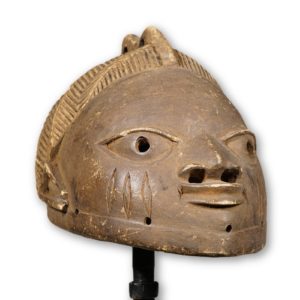
Yoruba African Gelede Mask 11.5″ in Length w/ Stand – Nigeria
$95.00View More -
Sale!

Unique Female Yoruba Statue 12.5″ – Nigeria – African Art
$45.00View More -
Sale!

Yoruba Statue with Articulated Arms 12.5″ – Nigeria – African Art
$45.00View More -
Sale!
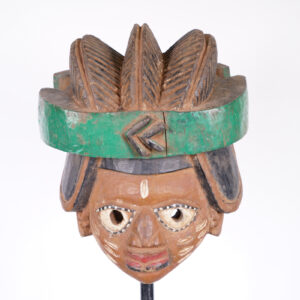
Colorful Yoruba Gelede Mask 11.25″ Long – Nigeria – African Art
$75.00View More -
Sale!
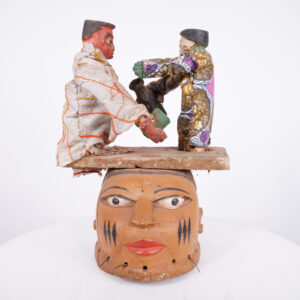
Colorful Yoruba Gelede Mask with Puppet Figures 16″ – Nigeria – African Art
$135.00View More -
Sale!
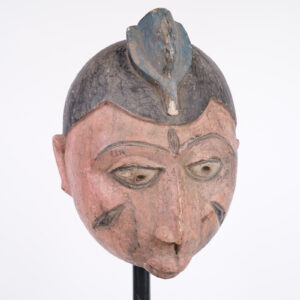
Yoruba Gelede Style Mask 11″- Nigeria – African Tribal Art
$50.00View More -
Sale!
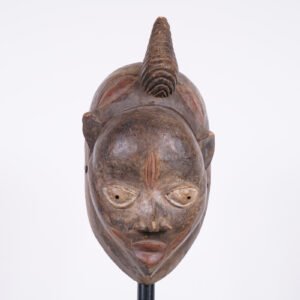
Interesting Yoruba Face Mask 13″ – Nigeria – African Tribal Art
$50.00View More -
Sale!
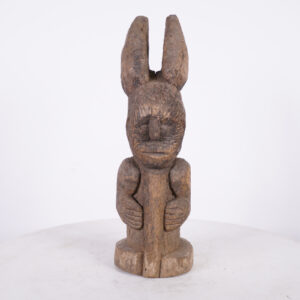
Interesting Yoruba Statue 15.75″ – Nigeria – African Tribal Art
$75.00View More -
Sale!

Yoruba & Benelulua Statue Lot 26.25″-28″- African Tribal Art
$135.00View More -
Sale!
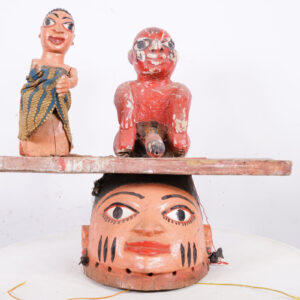
Colorful Yoruba Gelede Mask with Two Figures 17.5″ Wide – Nigeria
$95.00View More -
Sale!
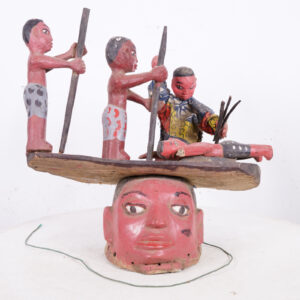
Colorful Yoruba Gelede Mask with Multiple Puppet Figures 15.25″ Wide – Nigeria
$175.00View More -
Sale!

Colorful Yoruba Gelede Mask with Puppet Figures 19″ Wide – Nigeria
$195.00View More

